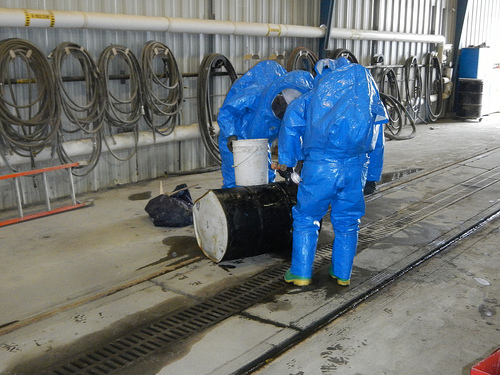The Occupational Safety and Health Administration (OSHA) has just proposed to revise its requirement that employers prepare and maintain records of occupational injuries and illnesses as they occur – in “I&I Logs.” (I blogged about these requirements here). Employers must also post annual I&I Summaries in each workplace, and respond to survey questions if asked by OSHA or the Bureau of Labor Statistics.
Audit, Compliance and Risk Blog
OSHA Proposes To Expand Enforceability Of Injury And Illness Reporting Requirements
Posted by Jon Elliott on Tue, Aug 18, 2015
Tags: Employer Best Practices, Health & Safety, OSHA, Employee Rights, Environmental risks, Environmental, EHS, Hazcom
OSHA Narrows Process Safety Management Exclusion For Retail Facilities
Posted by Jon Elliott on Tue, Aug 11, 2015
The Occupational Safety and Health Administration (OSHA) adopted its Standard for Process Safety Management of Highly Hazardous Chemicals (usually referred to as “PSM”) in 1992, to require extensive risk assessment and reduction efforts by facilities where a significant chemical incident might have catastrophic consequences. OSHA has made only minor technical revisions in the ensuing two decades. However, during that time OSHA has issued a series of regulatory interpretations and enforcement guidelines that affect how the Standard is implemented.
Tags: Health & Safety, Environmental risks, Environmental, Hazcom
Valley fever is an illness that usually affects the lungs and is caused by the microscopic fungus known as Coccidiodes immitis, which lives in the top two to twelve inches of soil. While the fungal spores may be present in soils throughout California, they are endemic in the Central Valley counties of Fresno, Kern, Kings, Madera, Merced, San Luis Obispo, and Tulare.
Tags: Employer Best Practices, Health & Safety, Employee Rights, California Legislation, Environmental risks, Environmental, EHS
When the majority of people hear the word “violence” they think of physical assault. Of course we know that acts of violence go beyond the physical to include any act in which a person is abused, threatened, intimidated, or assaulted. Every year almost two million U.S. workers report having been victimized by acts of workplace violence, yet many cases still go unreported. Workplace violence is a much bigger problem than many people realize, and it can happen anywhere at any time, and everyone is at risk.
Tags: Business & Legal, Employer Best Practices, Health & Safety, Employee Rights, Workplace violence, criminal background checks
DHS Prepares To Expedite Approval Of Chemical Facility Site Safety Plans
Posted by Jon Elliott on Tue, Jul 14, 2015
Late in May 2015, the Department of Homeland Security (DHS) issued guidelines under which qualifying chemical facilities can apply for expedited approval of site safety plans (SSPs) intended to protect the facilities against criminal or terrorist activity. These guidelines respond to a Congressional requirement included in amendments adopted in December 2014 to DHS’ Chemical Facility Anti-terrorism Standards (CFATS) program.
Tags: Health & Safety, Environmental risks, Environmental, Hazcom
Management of chemicals by your organization raises a host of environmental health and safety (EH&S) issues. Some of those issues are represented by legal and regulatory compliance requirements, others by formal but non-binding programs that range from company policies to ISO certifications. In response, organizations adopt and implement a wide variety of EH&S programs, including very broad ones (e.g., compliance with the Hazard Communication Standard) as well as very narrow ones (e.g., programs for managing entry into Confined Spaces). Organizations with sufficient resources and the will to organize themselves will create systematic programs to evaluate EH&S issues to ensure they’re addressed, and to design and coordinate programs in ways that do so effectively and efficiently. (In 2013-2014 I prepared a series of e-books that outlined EH&S regulatory requirements triggered by chemicals - click here to download).
Tags: Audit Standards, Health & Safety, OSHA, Environmental risks, Environmental, EHS, Hazcom
Did you know that “what you drive, how you drive, and what fuel you use can impact both the environment and your pocketbook?” The U.S. Environmental Protection Agency (EPA) has put together a Green Vehicle Guide website that provides useful information and answers to all your questions about how you can go green on the road and save money too.
Tags: Health & Safety, California Legislation, Training, Environmental risks, Environmental, EPA, Hazcom, Transportation
July 1 Deadline For California’s Revised Industrial Storm Water Requirements
Posted by Jon Elliott on Tue, Jun 30, 2015
The federal Clean Water Act (CWA) and state water quality laws (including California’s Porter-Cologne Water Quality Control Act) govern activities that may affect “waters of the United States.” Routine discharges from industrial and public sources make up most potentially polluting discharges, and are subject to National Pollutant Discharge Elimination System (NPDES) permits and California Waste Discharge Requirements (WDRs), but additional requirements also apply to potential “storm water” runoff from rainwater and snow, which can entrain oils and other pollutants and wash them down storm drains into water bodies. The US Environmental Protection Agency (EPA) established the first broad-based national program in 1990, and has revised and expanded requirements over the past quarter century (often in response to court decisions finding its efforts inadequate). States have followed suit. For example, in 2014 California updated its industrial storm water requirements, replacing a general permit adopted in 1997 with a new one that becomes effective on July 1, 2015. The new permit revises and expands requirements, including narrowing exemptions for “light industry” facilities to become conditional exemptions subject to certification requirements, and addition of detailed requirements for “preproduction plastic” materials. The remainder of this note summarizes the new California requirements, which generally are comparable to EPA’s national general permit (last updated in 2008)–so readers outside California should remember that your facilities face analogous responsibilities.
Tags: Health & Safety, California Legislation, Environmental risks, Environmental, EPA, Hazcom
You’ve likely heard it said that “everything we need to know we learned in kindergarten.” Well, that includes the benefits of taking a nap in the middle of the day, which has been shown to improve attitudes and enhance the ability to learn and manage tasks. Young children and elderly persons tend to nap, and napping is an important aspect of many cultures. However, as a nation, the United States appears to be becoming more and more sleep deprived. General reluctance to take naps may be attributed to a busy lifestyle and the demands of the North American workplace, or to the idea that napping will interfere with our nighttime sleep, or the stigma that napping equals laziness and results in poor productivity.
Tags: Corporate Governance, Business & Legal, Employer Best Practices, Health & Safety, Employee Rights, Training
EPA Promotes Green Infrastructure for Healthier Urban Environments
Posted by STP Editorial Team on Tue, Jun 09, 2015
What is “green infrastructure”? Green infrastructure incorporates vegetation, soils, and natural processes to manage water and create healthier urban environments. When talking about an area the size of an entire city or county, green infrastructure refers to an assorted collection of natural areas that provide habitat, flood protection, cleaner air, and cleaner water. When referring to an individual neighborhood or smaller locale, green infrastructure refers to stormwater management systems that simulate nature by soaking up and storing water, which then can be redirected back into sustainable usage by those communities.
Tags: Health & Safety, Environmental risks, Environmental, EPA, Transportation, Stormwater










